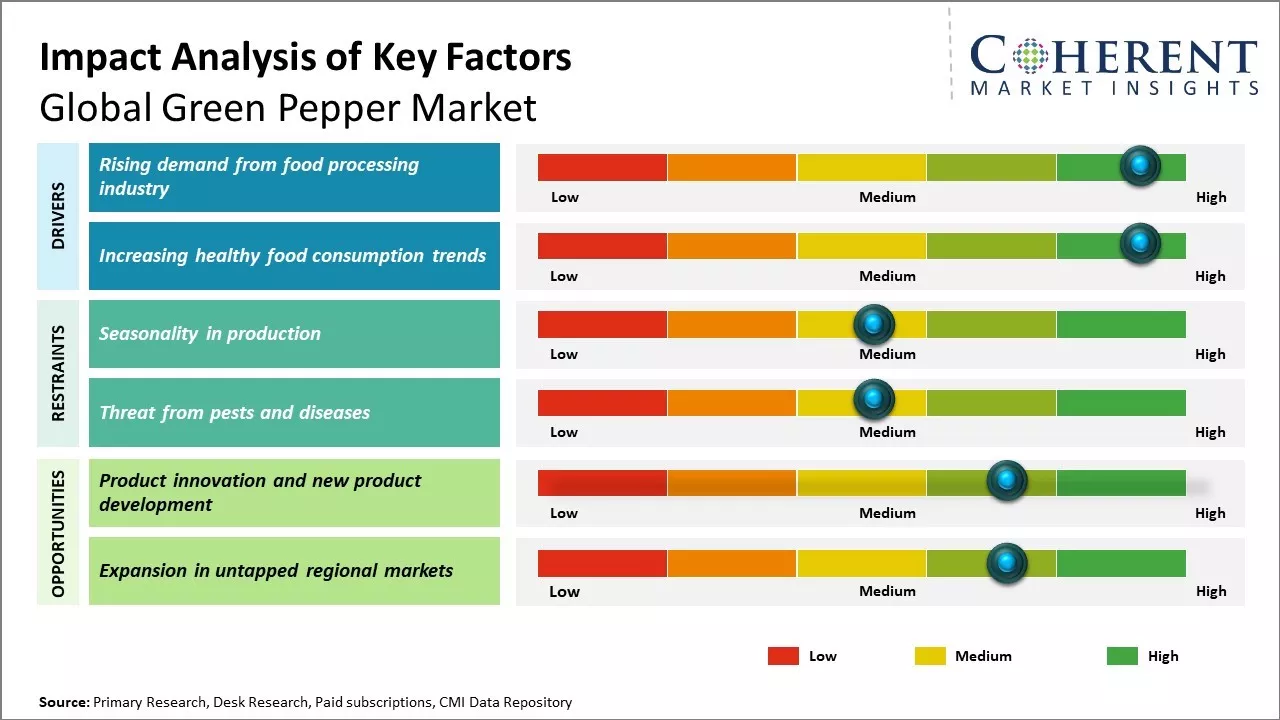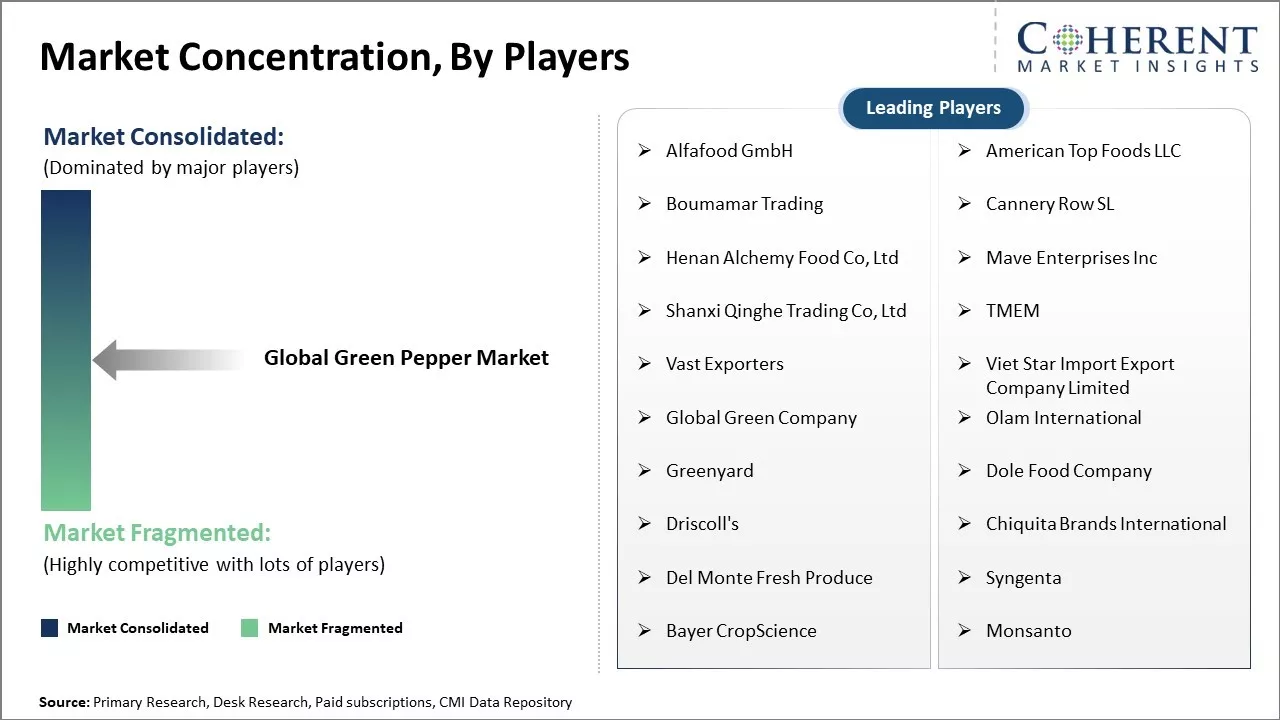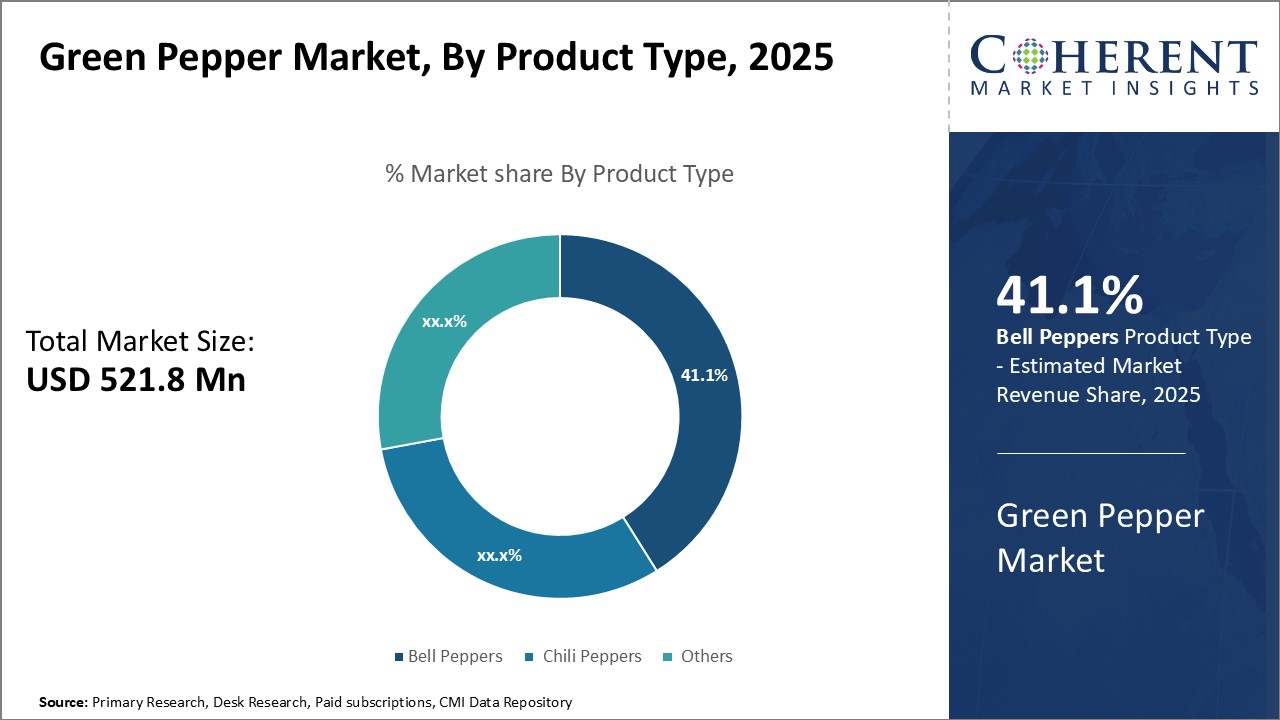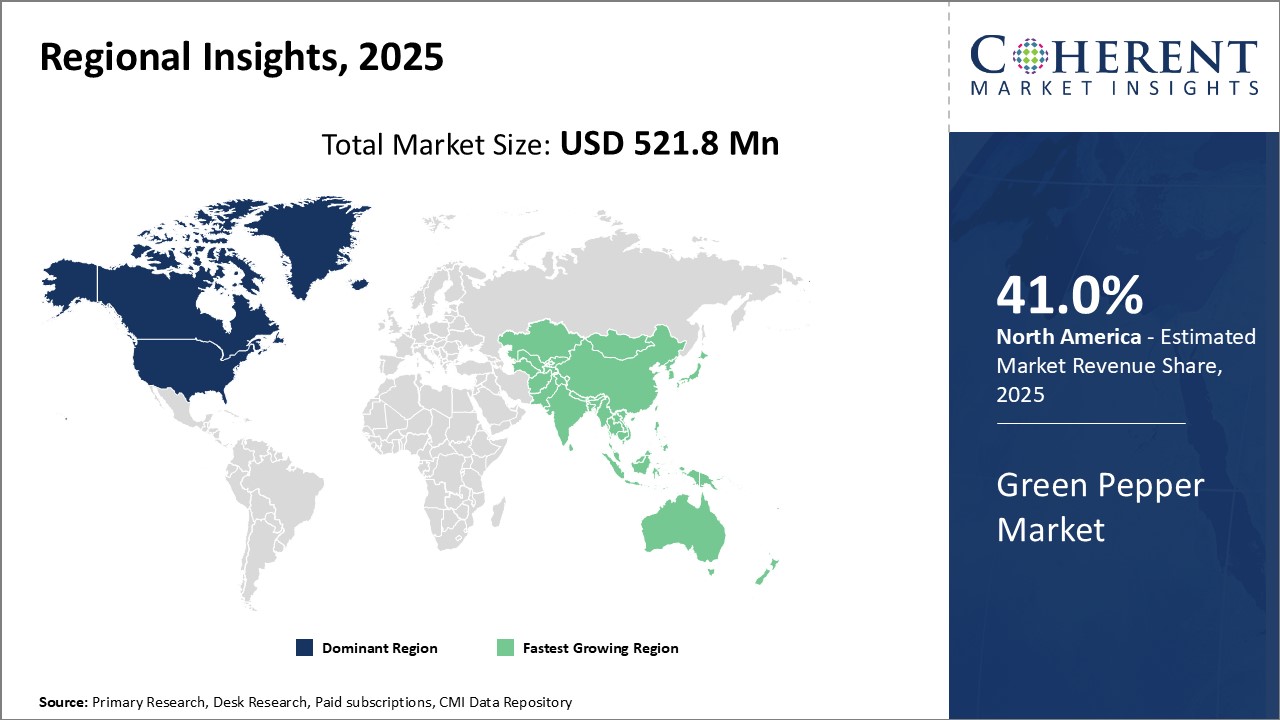Green Pepper Market Size and Trends
The global green pepper market is estimated to be valued at USD 521.8 Mn in 2025 and is expected to reach USD 624.9 Mn by 2032, exhibiting a compound annual growth rate (CAGR) of 2.6% from 2025 to 2032.

Discover market dynamics shaping the industry: Download Free Sample
The demand for green pepper is expected to increase in the Asia Pacific region mainly driven by countries like China and India owing to rising population and changing food habits, for instance according to data by Statista in 2023, India's population growth rate increased by 0.1 percentage points in 2023, the first increase in the observed period. North America is also expected to offer lucrative growth opportunities for green pepper producers and suppliers aided by the growing demand for ethnic cuisines and culinary usages in various Mexican, Italian, and Asian dishes. However, fluctuations in green pepper production due to changing climatic conditions and high energy and labor costs involved in green pepper farming can pose a challenge to smooth growth of the market during the forecast period. Innovation in farming techniques and the development of pest and disease resistant varieties can provide new opportunities for market participants.
Rising demand from food processing industry
The food processing industry has seen tremendous growth in the past decade owing to changing lifestyles and increased demand for convenience foods. The growing food industry is expected to drive the market growth. For instance, according to data published by Invest India in 2022, by 2025 the Indian food processing market is estimated to reach US$ 535 Bn, growing at a compound annual growth rate of 15.2%. Green peppers are increasingly being used as key ingredients in many processed food products. Food companies are launching a variety of snacks, sauces, and ready to eat meals containing green peppers. Pepper powder and flakes extracted from green peppers are used as seasoning in many snack foods. Pepper extracts are also added to soups, sauces, and other ready to meals for added flavor.
The demand for frozen and canned green peppers has also grown manifold as these forms offer convenience to both food processors and consumers. Major food giants such as Alfafood GmbH, American Top Foods LLC and other have increased their production of frozen pizza, burritos, and other meals containing green peppers to meet the on-go demand. The food service industry catering to institutional sectors like hotels, restaurants, and catering firms also source significant volumes of frozen and canned green peppers from suppliers. This helps them offer pan-regional menus without compromising on the availability of seasonal ingredients throughout the year.
Emerging convenience trends like meal kits containing partially cooked ingredients have also boosted the relevance of green peppers. Meal kit manufacturers value green peppers for their versatility – they can be used to make pastas, fajitas, stir fries, and curries with minimal effort. The growing popularity of these do-it-yourself home meal solutions has encouraged food companies to actively promote recipes featuring green peppers. Their mild flavor and crunchy bite complement a variety of global cuisines appealing to diverse target audiences.
Overall, the rising needs of food processing industry act as a key growth driver for the global green pepper market. As consumer preference for convenient and ready-to-eat options increases, the demand for green pepper from food manufacturers is expected to rise steadily over the coming years. Food companies will continue exploring innovative ways to incorporate green peppers into their product lines, further stimulating market revenues.
Market Concentration and Competitive Landscape

Get actionable strategies to beat competition: Download Free Sample
Increasing Healthy Food Consumption Trends
Growing health consciousness among consumers has elevated green peppers from a basic vegetable to a ‘superfood.’ Peppers are low in calories yet high in essential nutrients like vitamin C, vitamin A, vitamin K, and dietary fiber which are crucial for overall well-being. Just one cup of green peppers meets over 100% of an adult's daily vitamin C needs and only contains 25 calories – making them a favorable choice for health-driven diets.
The nourishing qualities of green peppers are magnified in times of illness or immunity related health issues. As the global pandemic highlighted people’s vulnerability, preventive health has gained precedence over reactive measures. With rising health issues such as obesity, diabetes, and cardiovascular diseases, consumers are increasingly preferring ingredients that act as protective foods rather than just sustenance.
Diet trends focusing on natural, fresh, and low-calorie ingredients have also uplifted green pepper consumption. Industries catering to wellness, like juicers, smoothie packs, and meal delivery startups actively include green peppers in their offerings. Celebrity endorsements of green pepper health hacks on social media have further popularized these greens among the masses. Today, green peppers feature heavily on menus catering to millennials as their vibrant color is considered photogenic as well. Health and diet centers provide juices/meals incorporating bell peppers to detox and nourish clients in a delicious way based on the latest dietary recommendations.
Clearly, the growing importance of preventive healthcare and nutritional lifestyles has become a huge opportunity for the green pepper market globally. As the demand for cleansing, immune-boosting superfoods rises, green peppers seem poised to take center-stage beyond basic salads/meals.
Key Takeaways from Analyst:
Several key factors will drive the demand for green peppers worldwide. Growing health consciousness among consumers is a major driver as green peppers are considered highly nutritious and contain many antioxidants and vitamins. Increasing use of green peppers in international cuisines is another driver expanding The global green pepper market globally. However, market growth could be restrained by high instability in pepper prices and supply shortage concerns due to climate change impacts on crop yields.
North America currently dominates the global green pepper market but Europe is showing most promise for future growth. Turkey is the largest producer as well as exporter of green peppers globally. Meanwhile, China is emerging as the fastest growing regional market in Asia Pacific due to rising incomes and shift to diets including more vegetables. Overall, opportunities for market expansion are high across developing nations as the consumption of fresh produce climbs rapidly with economic development.
Product innovation to suit evolving consumer needs will be critical for companies wanting to gain market share. Investment to improve agricultural productivity and ensure sustainable production practices can help address supply challenges. Adapting to shifts driven by issues like climate volatility means businesses must stay agile.
Market Challenge - Seasonality in production
One of the key challenges for the global green pepper market is seasonality in production. Green peppers are seasonal crops with well-defined planting and harvesting periods each year. However, consumer demand for green peppers remains strong throughout the year. The limited growing season creates fluctuations in supply and increases prices during off-seasons. Farmers around the world face difficulties in meeting year-round consumer demand due to adverse weather conditions and pests outside the ideal growing months. This affects production planning and creates inventory management issues for suppliers. Reliance on imports to bridge demand-supply gaps also pushes up overall costs. Seasonal shortages can negatively impact the competitiveness of green pepper producers in global markets. Weather-related disruptions pose further risks and call for development of alternative production zones and techniques to stabilize supplies.
Market Opportunity - Product innovation and new product development
One major opportunity for the global green pepper market lies in product innovation and new product development. With evolving consumer preferences, there is demand for novel green pepper varieties with unique flavors, appealing colors, enhanced nutritional profiles and longer shelf-lives. Investments into hybridization and genetic engineering methods can help introduce differentiated products to cater to niche customer segments. New forms of packaging tailored for on-the-go consumption also have scope. Comprehensive research focusing on post-harvest management practices may extend freshness durations and facilitate year-round availability. This can significantly boost volumes traded internationally. Standardized products suitable for processing industries additionally present opportunities for value addition. A focused approach towards innovation can assist green pepper players to gain a competitive edge and explore untapped market potential worldwide.

Discover high revenue pocket segments and roadmap to it: Download Free Sample
Insights by product type: Consumer Preference for Versatility Drives Bell Peppers Demand
In terms of product type, bell peppers is expected to contribute 41.1% share of the market in 2025, owing to its widespread usage in cuisines globally. Bell peppers come in various colors like green, red, yellow, and orange and bring visual appeal to dishes. Their mild flavor also allows bell peppers to be consumed raw or cooked in salads, sandwiches, pastas, and stir fries. Compared to chili peppers, bell peppers have a sweeter taste profile appreciated by people of all ages. Food trends celebrating the health benefits of colorful vegetables have also boosted demand. Bell peppers are low in calories and rich in vitamins C and A, providing antioxidants and anti-inflammatory properties. Their crunchy texture acts as a tasty snack option. As more people seek convenient ingredients for home cooking, ready-to-eat bell peppers demand is rising. Foodservice industry utilizes bell peppers as a ubiquitous ingredient to retain customers. Their adaptability in diverse cuisines cements bell peppers position as the dominant product type segment.
Insights by form: Focus on Freshness Drives Fresh Green Pepper Consumption
In terms of form, fresh green peppers is expected to contribute 39.4% share of the market in 2025, owing to consumer preference for the freshest ingredients. Unlike dried or canned varieties, fresh green peppers retain their original texture, flavor and nutrients upon consumption. Drying or canning leads to loss of moisture which affects sensory qualities. As people increasingly care about the source of their food, fresh peppers appeal due to their natural unprocessed state. Proper ripening during harvest also impacts flavor and sugar content favoring fresh purchases. Their extended shelf life after harvest allows distribution through conventional retail channels. Emerging farming technologies maintain freshness during transport. Households opt for fresh peppers to add vibrancy and crunch to home-cooked meals. Driven by trends of healthier snacking and conscientious consumption, demand for naturally fresh produce remains robust in this segment.
Insights by distribution channel: One-stop Shopping Convenience Boosts Hypermarket Sales
In terms of distribution channel, supermarkets/hypermarket is expected to contribute 37.3% of the market share in 2025, owing to the one-stop shopping convenience they offer consumers. Hypermarkets house all grocery necessities including green peppers under a single massive roof. Busy lifestyles encourage collective bulk purchases saved from multiple trips. This saves travel time and effort compared to visiting local markets or specialty shops. Dedicated veggie aisles offer clear visibility and accessibility for impulse buys. Stores promote green peppers through multi-buy deals and season-appropriate placement. Private label brands such as Trader Joe's and other increase price competitiveness to loyalty. Supermarkets leverage scale benefits to absorb overhead costs, passing savings to customers. Loyalty program perks retain shoppers under a single banner. Advanced supply chain management maintains consistent supply of agricultural goods. As centralized wholesale procurement hubs, hypermarkets deliver the most frictionless shopping experiences among all channels for green pepper buyers.
Regional Insights

Need a Different Region or Segment? Download Free Sample
The North America region currently dominates the global green pepper market due to strong demand from both domestic consumption as well as exports. The region is expected to hold 41.0% of the market share in 2025. The U.S. is the largest producer and exporter of green peppers worldwide. Major pepper producing states in the U.S. include California, Florida, New Jersey, and South Carolina. Mild weather conditions across many parts allow for year-round cultivation of peppers. Established transportation and logistics infrastructure enables efficient distribution to meet demand from Canada and Mexico, which are also among the top importers globally.
Most notably, the production of green peppers in Asia Pacific nations like Vietnam and Thailand has grown exponentially. Mild climates allow for multiple harvesting seasons. Lower operational costs and favorable regulations have attracted leading global producers such as Henan Alchemy Food Co, Ltd, Mave Enterprises Inc, to establish large-scale pepper farms. These nations are also strategically located for exports to Northeast Asian markets as well as the expanding domestic demand. As a result, Vietnam has surpassed Mexico to become the second largest green pepper supplier globally. With continued investment in cold chain infrastructure and trade relations, the Asia Pacific region will play a bigger role in meeting the strong demand growth projected over the coming years.
Market Report Scope
Green Pepper Market Report Coverage
| Report Coverage | Details | ||
|---|---|---|---|
| Base Year: | 2024 | Market Size in 2025: | USD 521.8 Mn |
| Historical Data for: | 2020 To 2024 | Forecast Period: | 2025 To 2032 |
| Forecast Period 2025 to 2032 CAGR: | 2.6% | 2032 Value Projection: | USD 624.9 Mn |
| Geographies covered: |
|
||
| Segments covered: |
|
||
| Companies covered: |
Alfafood GmbH, American Top Foods LLC, Boumamar Trading, Cannery Row SL, Henan Alchemy Food Co, Ltd, Mave Enterprises Inc, Shanxi Qinghe Trading Co, Ltd, TMEM, Vast Exporters, Viet Star Import Export Company Limited, Global Green Company, Olam International, Greenyard, Dole Food Company, Driscoll's, Chiquita Brands International, Del Monte Fresh Produce, Syngenta, Bayer CropScience, and Monsanto |
||
| Growth Drivers: |
|
||
| Restraints & Challenges: |
|
||
Uncover macros and micros vetted on 75+ parameters: Get instant access to report
Green Pepper Industry News
- In June 2024, Herbal Isolates, a leading provider of botanical extracts, announced its collaboration with St Jude, a startup specializing in agricultural innovation. The partnership aims to enhance the export potential of green peppers, leveraging the expertise and resources of both organizations to drive growth in the global agricultural market.
- In August 2024, Krispy Kreme delighted fans of both sweet treats and soft drinks by unveiling an exciting new collaboration with Dr. Pepper. This partnership brings a unique twist to the beloved doughnut brand, introducing a limited-edition line inspired by the iconic flavors of Dr. Pepper.
- In 2022, researchers from Sher-e-Kashmir University of Agricultural Sciences and Technology (SKUAST) unveiled a new variety of colored capsicums (bell peppers) that exhibit significant medicinal potential and antioxidant qualities. This innovative development aims to enhance both the agricultural landscape and the health benefits associated with capsicum consumption.
- In January 2022, the agritech startup Pepper Farms raised $1 million in seed funding to expand its business and strengthen its operations. The round was led by AxilorVentures and Himanshu Aggarwal, Co-founder of Aspiring Minds, with participation from other investors like Prof Tarun Khanna (Harvard Business School), Raman Uberoi (ex-COO CRISIL), Sunil Kalra (Via Projects), and Rahul Jain (Co-Founder Epigamia).
*Definition: The global green pepper market refers to the worldwide business of producing, processing, distributing and selling green bell peppers and other green chili varieties across international borders. Major players in this market cultivate green peppers and source supplies from farms around the world. They process, package and ship green peppers to distributors and retailers in different countries and regions. Key aspects of this global green pepper market include international trade agreements, export/import quotas, transportation and logistics, and others.
Market Segmentation
- By Product Type Insights (Revenue, USD Mn, 2020 - 2032)
- Bell Peppers
- Chili Peppers
- Others
- By Form Insights (Revenue, USD Mn, 2020 - 2032)
- Fresh Green Peppers
- Dried Green Peppers
- Canned Green Peppers
- By Distribution Channel Insights (Revenue, USD Mn, 2020 - 2032)
- Supermarkets/Hypermarkets
- Online Retail
- Local Markets
- Foodservice (Restaurants/Cafes)
- Wholesale
- Regional Insights (Revenue, USD Mn 2020 - 2032)
- North America
- U.S.
- Canada
- Latin America
- Brazil
- Argentina
- Mexico
- Rest of Latin America
- Europe
- Germany
- U.K.
- Spain
- France
- Italy
- Russia
- Rest of Europe
- Asia Pacific
- China
- India
- Japan
- Australia
- South Korea
- ASEAN
- Rest of Asia Pacific
- Middle East
- GCC Countries
- Israel
- Rest of Middle East
- Africa
- South Africa
- North Africa
- Central Africa
- North America
- Key Players Insights
- Alfafood GmbH
- American Top Foods LLC
- Boumamar Trading
- Cannery Row SL
- Henan Alchemy Food Co, Ltd
- Mave Enterprises Inc
- Shanxi Qinghe Trading Co, Ltd
- TMEM
- Vast Exporters
- Viet Star Import Export Company Limited
- Global Green Company
- Olam International
- Greenyard
- Dole Food Company
- Driscoll's
- Chiquita Brands International
- Del Monte Fresh Produce
- Syngenta
- Bayer CropScience
- Monsanto
Share
Share
About Author
Yash Doshi is a Senior Management Consultant. He has 12+ years of experience in conducting research and handling consulting projects across verticals in APAC, EMEA, and the Americas.
He brings strong acumen in helping chemical companies navigate complex challenges and identify growth opportunities. He has deep expertise across the chemicals value chain, including commodity, specialty and fine chemicals, plastics and polymers, and petrochemicals. Yash is a sought-after speaker at industry conferences and contributes to various publications on topics related commodity, specialty and fine chemicals, plastics and polymers, and petrochemicals.
Missing comfort of reading report in your local language? Find your preferred language :
Transform your Strategy with Exclusive Trending Reports :
Frequently Asked Questions
EXISTING CLIENTELE
Joining thousands of companies around the world committed to making the Excellent Business Solutions.
View All Our Clients
